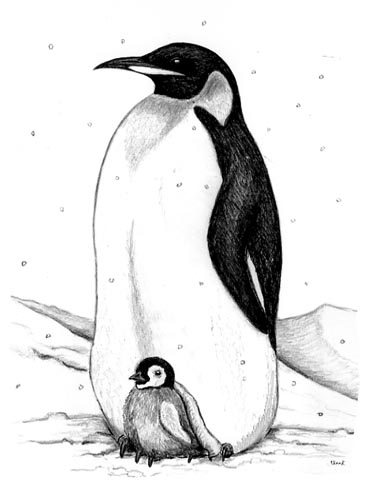
Dear Bird Folks,
I really enjoyed seeing the movie, “The March of the Penguins,” but thought some of it was a bit over dramatic. Also, it left me wanting to know about penguins. Have you seen this particular movie and, if so, what did you think about it?
– Ned, Sacramento, CA
Yeah Ned,
I saw “The March of the Penguins.” I see all the bird movies. There is no way that I’m going to pass on an opportunity to write off an $8.50 movie ticket on my taxes. However, I’m not sure if I’m qualified to write a movie review. I always seem to miss the point. Usually I read movie reviews after I’ve seen a movie in hopes the reviewer will tell me if I liked it and why. I remember going to see the first “Rocky” movie. I’m pretty sure I was the only one in the theater thinking that the movie was about a guy studying geology. Made sense to me.
If I were to write a review, I would have to agree with you Ned. “The March of the Penguins” is a visually stunning nature film about one of nature’s most amazing creatures. Unfortunately, there is a hokey narration by Morgan Freeman that tries to add some phony drama and I’m not sure why. The cinematography and the subject matter are so riveting that the narration, in my opinion, is more annoying than informative. Luckily, I found that if I chewed my popcorn loud enough, I could drown out Morgan’s voice and enjoy the birds.
Of the world’s 17 species of penguins, the stately Emperor Penguins (the stars of this movie) are the world’s largest. Standing 42″ tall and weighing up to 90 lb., a standing group of Emperor Penguins (called a “waddle” if you can believe it), look more like a bunch of lazy, out-of-shape kids at recess than a flock of birds. But in the water, these jumbo birds are masters. Using their stubby wings they are able to “fly” through the water, diving up to 900 feet and staying under for 15 minutes in search of food, which is mostly small fish, squid and the occasional lobster roll.
Emperor Penguins, along with the ridiculously cute Adelie Penguins, are the stereotypical snow and ice penguins. Most of the world’s other penguins can be found in warmer climates, spending more time in dirt and mud than on the ice. Penguins breed in Africa, Australia, New Zealand, Chile, Peru, and as far north as the Equator. Some penguins must survive in temperatures that reach 100 degrees below zero, while others live where it reaches 100 above. Because they can’t fly, they often nest in massive colonies on out-of-the-way islands where predators can’t get them and where neighbors won’t complain about the smell.
We’ve all seen nature shows about the mind-boggling things that wild creatures can do. From the organized labor in a bee hive, to the intricate work of a lone spider spinning a web, the wonders of nature can be astounding. Right near the top of that list certainly must be the breeding cycle of the Emperor Penguin. What those birds go through to raise a single chick would make most creatures seriously consider adopting. Unlike most birds (you already know this part Ned – this is for the others who haven’t forked over the $8.50 to see the movie yet.), Emperor Penguins don’t nest in the lovely springtime, but in the threatening fall. Breeding in the fall is never a good idea, but when you are about to face an Antarctic winter, it’s just plain nuts. Still, these fat, stubby birds haul out of the ocean each fall and hike (waddle), single file, fifty miles or more over snow and ice to reach their breeding grounds. After an egg is laid and the deep, dark and very cold winter is about to begin, the female penguin hands off the single egg to the male. She then heads back to the ocean, leaving him alone with the egg resting on his feet, hidden under his fat penguin belly.
For the next two months the male penguin’s only job is to protect and hatch that one egg. He stands in near total darkness, while facing the worst weather on earth, and without ever eating a single bite of food. Don’t ask me why he signed up for that job, but clearly he didn’t think it through.
If anyone wants to find out how the story turns out, you’ll just have to see the movie, and well you should. The photography is truly stunning. The daily challenges that face these birds are almost beyond belief. And with the help of a bag of popcorn, you too can drown out the hokey narration. But remember, it’s movie theater popcorn. If you want to buy a large bag, better start saving now.